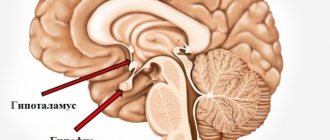Phakomatosis is not a separate disease, but a whole group of neurocutaneous pathologies. Different types of phakomatoses share a similar origin. Despite the common pathogenesis, their symptoms are very diverse, which complicates the diagnosis and treatment regimen.
Diseases of this group were first described in the 20s of the last century. Researchers have identified more than 50 forms of hereditary disorders of different parts of the nervous system with damage to the skin, eyes, internal organs, and a tendency to the appearance of tumors.
In the International Classification of Diseases ICD-10 system, phakomatoses are designated by code Q85.
What are phakomatoses?
Phakomatoses are congenital diseases associated with deviations in the development of the nervous system in the prenatal period. Typically, the underlying causes of the disease are due to hereditary factors. Due to gene mutations, the formation of the nervous system occurs incorrectly even at the stage of intrauterine development. It is significant that not all consequences make themselves felt immediately after a person’s birth. Neurological signs in patients also appear as they grow older: in adolescence or already in adulthood.
Despite the varied symptoms, common to all types of phakomatosis is a tendency to form tumors. These neoplasms can be of different locations and have a very different character. The most common are fibromas, papillomas, hemangiomas, and skin pigment spots.
Phakomatoses include Bourneville disease (tuberous sclerosis), neurofibromatosis types 1 and 2, Sturge syndrome (encephalotrigeminal hemangioblastosis), Ito hypomelanosis and a number of other varieties - about 30 types of phakomatosis in total. Each of them has its own distinctive features, symptoms, course and prognosis.
Symptoms and signs of phakomatosis
The earliest symptoms are skin manifestations of the disease, which appear at an early age. Later they are joined by neurological and other symptoms.
It is hardly possible to describe the manifestations of each of the 30 types of disease in one material. Let us note only the main features of the most common cases. For example, with tuberous sclerosis there are:
- convulsions and epileptic attacks (manifest immediately after birth);
- spots on the skin, colorless, but with clear boundaries (also from the moment of birth);
- retardation in mental and mental development;
- examinations reveal changes in some convolutions of the brain, mutations of genes in chromosomes;
- benign neoplasms in the tissues of internal organs (the presence of tumors in the heart muscle leads to death).
With neurofibromatosis, tumors called neurofibromas form on or under the skin.
Damage to the central nervous system can lead to disruptions in the functioning of various organs and inhibition of their functions:
- breathing problems;
- problems swallowing food;
- malfunctions of internal organs: heart, kidneys, etc.;
- vision pathologies;
- pyramidal symptoms (movement disorders).
With some types of phakomatosis, mental abnormalities may be absent. In others, the greatest danger is the rapid growth of tumors and their transformation into low-quality, cancerous formations. Often the patient's immunity is impaired, immunodeficiency develops, and a tendency to infectious diseases develops. In addition, endocrine disorders may appear: obesity, diabetes insipidus, puberty disorders. Another fairly common, but nonspecific symptom is vegetative-trophic disorders (dry and flaky skin, brittle nails, hair loss).
Common manifestations of all forms of the disease are:
- spots or rashes on the skin;
- epileptic seizures;
- seizures;
- sleep disorders (insomnia at night and drowsiness during the day);
- antisocial tendencies in behavior;
- dysfunction of the visual organs;
- cerebellar dysfunction (impaired coordination of movements);
- in some cases, premature aging is added to the manifestations.
Clinic of phakomatosis
Polymorphic damage to the skin, nervous system, and internal organs is a characteristic sign of phakomatosis. Signs of neurological and dermatological syndromes appear in early childhood, as they are congenital. Much later other signs appear. In some clinical cases, phakomatosis occurs against the background of congenital immunodeficiency, combined with premature aging and the risk of developing cancer.
Lesions of the nervous system are expressed in formations in the medulla and membranes. Most often, cysts, subependymal nodes, neurofibromas, calcifications, and areas of atrophy or demyelination appear. The patient is diagnosed with congenital anomalies of the cerebral vessels - aneurysms, angiomas. Often a convulsive syndrome appears with various forms of attacks.
West syndrome is recorded in early childhood. Older children experience generalized and partial sensorimotor epileptic seizures, and Lennox-Gastaut syndrome manifests itself. Epileptic seizures and disorders of brain structures lead to mental retardation, speech disorders, mental retardation, and abnormal behavior. The degree of mental retardation is related to the frequency and severity of epileptic seizures and can vary from debility to idiocy.
Patients experience disorders in the functioning of the cranial nerves - oculomotor disorders, hearing pathologies, paresis of the facial nerve. There are signs of cerebellar ataxia, sleep disorganization in the form of insomnia or somnambulism. From the extrapyramidal areas - tonic muscle symptoms, hyperkinesia, bradykinesia. The patient's behavior is disrupted until the development of ADHD or autism.
Metamorphoses of the skin with phakomatoses appear in the first months of life. The spots on the skin are asymmetrical, can have different colors, sizes, single or multiple. Patients most often experience age spots, dermatofibromas, areas of reduced pigmentation, papillomas, angiomas, and shagreen plaques.
The phenomena of phakomatosis are accompanied by disorders of the endocrine system in the form of diabetes insipidus, hypothyroidism, and obesity. Children experience delayed or early puberty, and on the part of the autonomic nervous system - trophic disorders in the form of brittle nails, dry skin, and hair loss. Ophthalmologists detect damage to the visual organs of congenital origin or early manifestation. During the examination, angiomatosis, retinal hamartomas, and conjunctival telangiectasia are detected. There is a decrease in the quality of vision.
On the part of the internal organs, the development of neoplasms is noted. Most often, tumors are benign in origin, but they can recur and progress. Children suffering from phakomatosis are more prone to infectious diseases than others, which lead to complications from the underlying disease.
Causes of the disease
Changes in the body that lead to phakomatosis begin with human DNA. It is believed that mutations of two genes are to blame - TSC1 and TSC2. This is a group of pathologies with a purely hereditary genesis.
Mutations lead to disruption of the production of two proteins responsible for counteracting tumor processes - hamartin and tuberin. As a result, numerous neoplasms appear in the tissues of various organs and parts of the body. As a rule, the disease develops “out of the blue”, without any preliminary, “warning” symptoms.
Any adverse effects on the fetus can cause disturbances in the development of the central nervous system, and even more so if they affect genetics. Inheritance occurs in an autosomal dominant manner with a probability of 0 to 50 percent. This means that up to half of the representatives of each next generation can receive the mutated gene from their father or mother.
Features of the group of diseases
Phakomatoses were first described as a large group of hereditary diseases in the 20s of the last century.
This group includes pathological conditions associated with changes in the skin in combination with damage to the organs of vision, various parts of the nervous system and internal organs (more than 50 nosological forms in total). Clinically, phakomatoses are detected at an early age or immediately after birth, usually as dermatological manifestations. At the same time, neurological symptoms may appear much later - in adolescence and adulthood. Unlike congenital malformations, this pathology has a steadily progressive course.
All types of disease are based on mutations in genes responsible for the production of a suppressor (suppression factor) of tumor growth.
Inheritance of the pathology occurs vertically from parents to children according to the autosomal dominant type (half of the children will receive the abnormal gene from their mother or father).
These diseases are distinguished by significant heterogeneity - along with severe prognostically unfavorable forms, erased monosymptomatic variants are observed.
Common to all types of phakomatoses is the presence of multiple tumor growths - these are hemangiomas, fibromas, papillomas, telangiectasias and pigment spots on the skin. At the same time, each nosological form has specific features.
What diseases are classified as phakomatoses?
The modern classification of phakomatoses includes about 30 different forms of pathology. The forms that have been best studied by medicine are those that are more common and occur more often than other forms:
- tuberous sclerosis;
- neurofibromatosis types 1 and 2;
- phakomatosis fifth;
- encephalotrigeminal phakomatosis;
- Ito hypomelanosis;
- Louis-Bar syndrome;
- Klippel syndrome;
- Bourneville disease;
- Sturge-Weber syndrome;
- albinism.
Phakomatoses: classification
Today, there are about 30 forms of pathologies related to neurocutaneous syndromes. The most common and thoroughly studied types of phakomatosis include:
- Bourneville syndrome. It seems to be the most severe phacomatous type of the disease, which begins to manifest itself in a child in preschool age. This type is otherwise called tuberous sclerosis. A patient with this type has an adenoma of the sebaceous glands and signs of dementia.
- Sturge-Weber syndrome. Characterized by the presence of age spots on the face and delayed intellectual development.
- Neurofibromatosis RecklinghauseFna. This type of phakomatosis is recorded much more often than other possible types of the disease. It is the most studied form and is characterized by the appearance of age spots on the body and tumors, both on the skin itself and in the subcutaneous tissue.
- Hippel-Lindau syndrome. (cerebroretinal angiomatosis). It is characterized by simultaneous damage to the retina and an area of the brain (usually the cerebellum). With this type, certain changes begin to develop in the pancreas.
Rare forms of phakomatosis include:
- Ito's hypomelanosis . It is characterized by hypopigmentation of skin areas in the form of marble stains. Has extensive symptoms (epileptic seizures, autism, dementia). To date, isolated cases of inheritance of this disease have been described.
- Neurofibromatosis type 2 . This type is registered in 1 case out of 40,000. It is characterized by a long asymptomatic course with the presence of tumor formations in the patient, however, the growth of these tumors occurs very slowly, as a result of which the manifestation of symptoms occurs in adolescence or after 30 years.
- Albinism. One of the rarest forms of phakomatosis, the occurrence of which is caused by a gene mutation that leads to the absence of the pigment component - melanin. It is characterized by such manifestations as pale skin with translucent blood vessels, hair, eyebrows and eyelashes take on a white color.
Diagnostics
To diagnose phakomatosis in children, you should first consult a pediatrician; in older people, you should consult your general practitioner. The doctor will refer the patient for consultation to a number of specialized specialists: ophthalmologist, neurologist, dermatologist, nephrologist, cardiologist, gastroenterologist, endocrinologist. Also, due to the hereditary nature of the disease, a geneticist’s opinion will be required. The full list of specialist doctors depends on the manifestations of the disease.
After studying the patient’s complaints, clinical picture, and medical history, the patient can be sent for a number of examinations:
- blood chemistry;
- general blood analysis;
- general urine analysis;
- genetic testing;
- electroencephalography (EEG);
- electrocardiogram (ECG);
- magnetic resonance imaging (MRI);
- CT scan ();
- ophthalmoscopy;
- ultrasound examination (ultrasound) of the brain and internal organs;
- angiography;
- echocardiography.
Diagnosis is complicated by the variety of clinical manifestations in different forms and at different ages. However, the examination data collected together will be able to give doctors the basis for the main conclusion: whether the patient has phakomatosis or not.
Clinical signs of the disease
The symptoms of all types of phakomatosis are quite typical. It is mainly expressed by the release of a polymorphic rash, as well as pathology of various structures of the central nervous system and internal organs. It is worth highlighting that when the disease develops at an early age, characteristic neurological signs are detected much later than dermatological symptoms.
Sometimes the disease is correlated with premature aging, the acquisition of normal tissue by cells, and also with the properties of a malignant tumor.
The most common clinical symptoms of phakomatosis are:
- Frequent seizures in childhood, which often cause mental retardation in the child, mental retardation and antisocial behavior.
- Violation of visual and auditory functions;
- Manifestation of various extrapyramidal pathologies (hyperkinesia and a number of others);
- Impaired coordination due to severe cerebellar dysfunction;
- Sleep disturbance;
Dermatological signs often appear in the first few weeks of life. The rash itself can be single or multiple, have a different color and shape. A typical rash primarily includes pigment spots with a brownish tint, neurofibromas, papillomas, hemangiomas and shagreen skin with plaques.
In some cases, the disease is accompanied by symptoms typical of an endocrine system disorder. Patients also show pathological signs of a vegetative-trophic nature:
- Hair loss;
- Brittle nails;
- Dryness and flaking of the skin.
Damage to the eyeballs is often noted immediately after the birth of the baby. In some cases, there is an asymptomatic course of the disease, which can be distinguished only by slightly reduced visual acuity. The pathological state of the organs is determined by the tumors developing in it, which, as a rule, are benign in nature, but are often prone to relapse and general growth.
Treatment
Phakomatoses are treated both with medication and with surgical intervention. Psychotherapeutic treatment is also used. There is no generally accepted treatment according to a single treatment regimen for this pathology. Therapy depends on the type of disease and the specific symptoms of each patient. We can only talk about symptomatic treatment with medications. If it is ineffective, surgical intervention is usually considered.
The main groups of drugs used in therapy:
- Anticonvulsants.
- Dehydrating (diuretic) drugs.
- Neurometabolic drugs (except in cases with symptoms of epilepsy, when drugs that stimulate them are prohibited).
For seizures and epilepsy, anticonvulsant therapy plays an important role. A drug for treatment is selected for the child, and this is one of the first steps - frequent seizures negatively affect mental development.
When tumor formations grow, surgery is performed to remove them. Tumors can form in various parts of the body and organs, including the brain. The complexity of the operation can vary - from the removal of small papillomas on the skin to neurosurgical interventions to remove oncological brain tumors. The operation is also indicated for venous and arterial pathologies (for example, aneurysms).
With phakomatosis in children, psychocorrective therapy is often necessary. It is designed to help the child better adapt to society, the children's group, study in kindergarten, school according to a program feasible for him, improve his intelligence and develop his abilities.
If the patient has symptoms of visual impairment, coordination, movement, or neurological manifestations of the disease, then the appropriate doctors (ophthalmologist, neurologist, etc.) are involved in the therapy and the necessary treatment is prescribed.
Possible complications
Any injuries or infectious diseases suffered by a patient with phakomatosis can significantly worsen the course of this disease. Considering the fact that the patient’s immune defense is severely affected, one must beware of infections, viral diseases, etc.
A dangerous complication of phakomatosis is the threat of degeneration of benign tumors into cancerous formations. If tumors are located in parts of the brain, signs of hydrocephalus, increased intracranial pressure, and compression of cerebral vessels with all the ensuing consequences may appear. If vital areas are affected, respiratory arrest and clinical death of the patient are possible.
A patient with phakomatosis needs to be observed by several medical specialists throughout his life and undergo regular examinations in order to detect complications in a timely manner and begin treatment.
Forecast and prevention of phakomatosis
Unfortunately, phakomatoses are diseases with not the most favorable prognosis. Predicting the outcome of treatment is not always easy. The outcome depends on the specific type of phakomatosis, the severity of the disease, and the age of the patient at which symptoms began to appear. When tumors affect areas of the brain responsible for vital functions, death is inevitable.
A feature of some phakomatoses is that the manifestations of the disease differ greatly with the onset of its symptoms at different ages. This creates difficulties in diagnosis and treatment. If a diagnosis has been made, in no case should you immediately give up on a sick child (just as adult patients should immediately lose heart). Even if we are not talking about a complete cure, it is quite possible to keep the disease under control.
Prevention of this pathology consists of genetic counseling of parents before conceiving a baby, the desire of both to give birth to a healthy child, as well as doctors monitoring the woman’s health throughout pregnancy.










